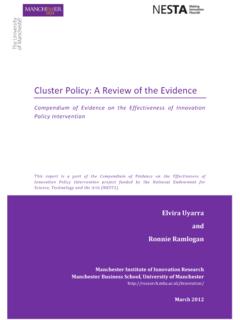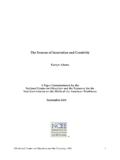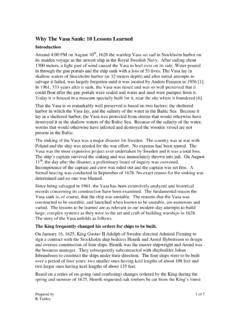Transcription of The Impact of Standardization and Standards on Innovation
1 1 Manchester Institute of Innovation Research The Impact of Standardization and Standards on Innovation Compendium of Evidence on the Effectiveness of Innovation Policy Intervention Knut Blind TU Berlin, Fraunhofer FOKUS, RSM Erasmus University Manchester Institute of Innovation Research Manchester Business School, University of Manchester February 2013 The Impact of Standardization and Standards on Innovation Blind 2 Manchester Institute of Innovation Research This report is part of the Compendium of Evidence on the Effectiveness of Innovation Policy Intervention Project led by the Manchester Institute of Innovation Research (MIoIR), University of Manchester. The project is funded by the National Endowment for Science, Technology and the Arts (NESTA) - an independent body with the mission to make the UK more innovative.
2 The compendium is organised around 20 Innovation policy topics categorised primarily according to their policy objectives. Currently, some of these reports are available. All reports are available at Also at this location is an online strategic intelligence tool with an extensive list of references that present evidence for the effectiveness of each particular Innovation policy objective. Summaries and download links are provided for key references. These can also be reached by clicking in the references in this document. The Impact of Standardization and Standards on Innovation Blind 3 Manchester Institute of Innovation Research Table of Contents Table of Figures .. 4 List of Tables .. 4 Executive Summary .. 5 1 Introduction .. 6 Definitions.
3 6 Types of Standards and their effects on 7 2 Function of Standardization and Standards in the context of specific Innovation activities 10 Research and Standardization .. 10 IPR and Standardization .. 13 Standards in public procurement .. 14 3 Empirical Evidence .. 17 The general economic Impact of 17 The Impact of Standards on Innovation .. 19 Research and Standardization .. 22 IPR and Standardization .. 22 Standards in public procurement .. 23 4 Summary and Outlook .. 25 5 References .. 28 The Impact of Standardization and Standards on Innovation Blind 4 Manchester Institute of Innovation Research Table of Figures Figure 1: Research trends for Standardization and Innovation for 1995 2008 (Choi et al. 2011, p. 263) .. 7 Figure 2: Major subject domains of the publications on Innovation and Standardization .
4 8 Figure 3: Research and standardisation in a simple technology transfer model .. 12 Figure 4: Various roles of different types of Standards in the Innovation process .. 13 Figure 5: Role of Standards in public procurement .. 17 Figure 6: Likelihood of aspects included in the specifications of tenders .. 24 Figure 7: Intensity of co-operation with different institutions during the tendering procedure 25 List of Tables Table 1: Exploratory taxonomy for literature on Standardization and Innovation .. 8 Table 2: Types of Standards and their Effects on Innovation .. 10 Table 3: National studies of the effects of Standards on economic growth .. 18 Table 4: Types of Standards and Role of Public Policy in order to Promote Innovation .. 27 The Impact of Standardization and Standards on Innovation Blind 5 Manchester Institute of Innovation Research Executive Summary In the past, standardisation and Standards have often been perceived as a contradiction to Innovation .
5 This report provide conceptual arguments and empirical evidence that Standardization as such and Standards can be used as to promote Innovation especially in three different areas. After a brief section on the general economic functions of Standards , the relationship between research and standardisation is examined by first showing both Standardization as a technology transfer channel and Standards as enablers and facilitators for research. The second area focuses on the difficult but promising issue of transferring intellectual property rights (IPR) into Standards , and shows how this can be beneficial both for IPR holders and Standards implementers. The third newly emerging field concerns the role of Standards and Standardization in procurement processes, which are more and more forced to address and promote Innovation .
6 In the final chapter, the results are summarised and recommendations for policy makers are derived.. The Impact of Standardization and Standards on Innovation Blind 6 Manchester Institute of Innovation Research 1 Introduction Standards form the basis of our professional and private life and Innovation is the major source of growth and welfare for our economies. The challenge both for decision makers in industry and policy is an effective and efficient use of Standardization also to promote Innovation , especially since the traditional view has always been that Standards and Innovation contradict each other. This perception had some negative implications for the integration of Standardization both in companies Innovation processes and in a comprehensive Innovation policy.
7 Here, we observed in the past a strong focus on public funding of research and development and on intellectual property rights (IPR) as instruments of Innovation policy. However, economic impacts of research results and IPR can only be realised through their successful transfer into innovative products and processes. Unfortunately Standardization has not yet been used in a comprehensive sense as effective and efficient technology transfer channel. In addition, Standards can play an effective leveraging and diffusion mechanism for IPR. However, this might also create possible conflicts between the actors involved. Standardization is also a platform used by researchers and other actors in the Innovation process, and Standards are important elements in the framework conditions for research, development and Innovation .
8 Finally, user driven Innovation strategies and consequently demand driven Innovation policies have recently been promoted, but Standardization as a tool to coordinate the preferences and actors of the demand side has not been considered. In sum, there is a large potential for Standards and Standardization to promote Innovation for policy makers. However, only recently have we observed some policy initiatives, such as the Lead Market Initiative of the European Commission and some national Innovation strategies now focusing on Standardization as a crucial Innovation policy instrument. This report will give an overview of the function of Standardization and Standards to promote Innovation from a conceptual view in the second chapter, which is complemented by an overview of the existing, but limited empirical evidence in the third chapter.
9 The report is concluded by a summary and a set of recommendations how policy makers should use Standardization and Standards in shaping future Innovation policies. Definitions Facing a controversial discussion about the definition of Standardization and Standards (De Vries 1997), we make use of the official definition of the International Organization for Standardization (ISO) and the International Electrotechnical Commission of standardisation (IEC) as producing documents by consensus and approved by a recognized body, that provides, for common and repeated use, rules, guidelines or characteristics for activities or their results, aimed at the achievement of the optimum degree of order in a given context (ISO/IEC Guide 2004). The key point is that Standardization is a voluntary process for the development of technical, but more and more also other types of specifications based on consensus amongst the interested parties themselves: industry in first place, but also a variety of users, interest groups and public authorities.
10 Standards , as result of Standardization , have the following characteristics. They are made available to the public free of charge or for a mostly cost covering fee. Implementation is in general free of charge. Only in some cases they are subject to The Impact of Standardization and Standards on Innovation Blind 7 Manchester Institute of Innovation Research the payment of compensation to owners of related IPR, mostly patents (Blind et al. 2011). Finally, the usage of Standards remains voluntary, although harmonised European Standards are part of the regulatory framework within the context of the so called new approach ( ).1 Formal standardisation includes the following organisations. Standardisation bodies such as British Standards Institution (BSI) are the institutions responsible at the national level.







